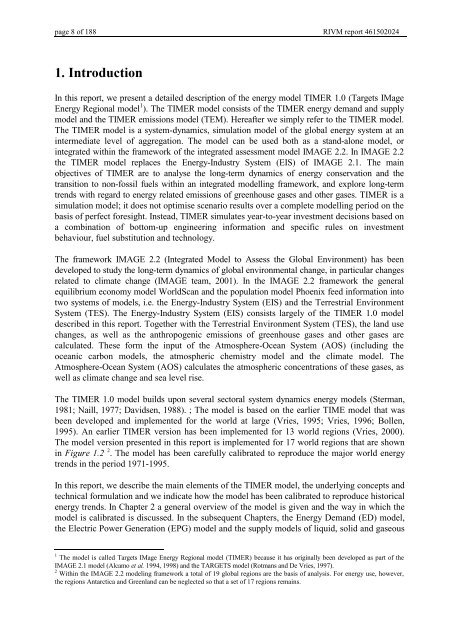Targets IMage Energy Regional (TIMER) Model, Technical ...
Targets IMage Energy Regional (TIMER) Model, Technical ...
Targets IMage Energy Regional (TIMER) Model, Technical ...
You also want an ePaper? Increase the reach of your titles
YUMPU automatically turns print PDFs into web optimized ePapers that Google loves.
page 8 of 188 RIVM report 461502024<br />
,QWURGXFWLRQ<br />
In this report, we present a detailed description of the energy model <strong>TIMER</strong> 1.0 (<strong>Targets</strong> <strong>IMage</strong><br />
<strong>Energy</strong> <strong>Regional</strong> model 1 ). The <strong>TIMER</strong> model consists of the <strong>TIMER</strong> energy demand and supply<br />
model and the <strong>TIMER</strong> emissions model (TEM). Hereafter we simply refer to the <strong>TIMER</strong> model.<br />
The <strong>TIMER</strong> model is a system-dynamics, simulation model of the global energy system at an<br />
intermediate level of aggregation. The model can be used both as a stand-alone model, or<br />
integrated within the framework of the integrated assessment model IMAGE 2.2. In IMAGE 2.2<br />
the <strong>TIMER</strong> model replaces the <strong>Energy</strong>-Industry System (EIS) of IMAGE 2.1. The main<br />
objectives of <strong>TIMER</strong> are to analyse the long-term dynamics of energy conservation and the<br />
transition to non-fossil fuels within an integrated modelling framework, and explore long-term<br />
trends with regard to energy related emissions of greenhouse gases and other gases. <strong>TIMER</strong> is a<br />
simulation model; it does not optimise scenario results over a complete modelling period on the<br />
basis of perfect foresight. Instead, <strong>TIMER</strong> simulates year-to-year investment decisions based on<br />
a combination of bottom-up engineering information and specific rules on investment<br />
behaviour, fuel substitution and technology.<br />
The framework IMAGE 2.2 (Integrated <strong>Model</strong> to Assess the Global Environment) has been<br />
developed to study the long-term dynamics of global environmental change, in particular changes<br />
related to climate change (IMAGE team, 2001). In the IMAGE 2.2 framework the general<br />
equilibrium economy model WorldScan and the population model Phoenix feed information into<br />
two systems of models, i.e. the <strong>Energy</strong>-Industry System (EIS) and the Terrestrial Environment<br />
System (TES). The <strong>Energy</strong>-Industry System (EIS) consists largely of the <strong>TIMER</strong> 1.0 model<br />
described in this report. Together with the Terrestrial Environment System (TES), the land use<br />
changes, as well as the anthropogenic emissions of greenhouse gases and other gases are<br />
calculated. These form the input of the Atmosphere-Ocean System (AOS) (including the<br />
oceanic carbon models, the atmospheric chemistry model and the climate model. The<br />
Atmosphere-Ocean System (AOS) calculates the atmospheric concentrations of these gases, as<br />
well as climate change and sea level rise.<br />
The <strong>TIMER</strong> 1.0 model builds upon several sectoral system dynamics energy models (Sterman,<br />
1981; Naill, 1977; Davidsen, 1988). ; The model is based on the earlier TIME model that was<br />
been developed and implemented for the world at large (Vries, 1995; Vries, 1996; Bollen,<br />
1995). An earlier <strong>TIMER</strong> version has been implemented for 13 world regions (Vries, 2000).<br />
The model version presented in this report is implemented for 17 world regions that are shown<br />
in )LJXUH 2 . The model has been carefully calibrated to reproduce the major world energy<br />
trends in the period 1971-1995.<br />
In this report, we describe the main elements of the <strong>TIMER</strong> model, the underlying concepts and<br />
technical formulation and we indicate how the model has been calibrated to reproduce historical<br />
energy trends. In Chapter 2 a general overview of the model is given and the way in which the<br />
model is calibrated is discussed. In the subsequent Chapters, the <strong>Energy</strong> Demand (ED) model,<br />
the Electric Power Generation (EPG) model and the supply models of liquid, solid and gaseous<br />
1 The model is called <strong>Targets</strong><strong>IMage</strong> <strong>Energy</strong> <strong>Regional</strong> model (<strong>TIMER</strong>) because it has originally been developed as part of the<br />
IMAGE 2.1 model (Alcamo HWDO 1994, 1998) and the TARGETS model (Rotmans and De Vries, 1997).<br />
2 Within the IMAGE 2.2 modeling framework a total of 19 global regions are the basis of analysis. For energy use, however,<br />
the regions Antarctica and Greenland can be neglected so that a set of 17 regions remains.
















